Best Above-Knee Prosthetic Legs & Expert Treatment

What is an Above-Knee Prosthetic Leg?
Above-knee prosthetic leg is a prosthetic system designed for legs amputated above the knee joint, either in one or both legs
Above-Knee Prosthetic Leg Types
There are 3 types of products regarding above-knee prosthesis.
When selecting the most suitable above-knee prosthetic leg for the patient, technicians evaluate the patient’s age and activity level, and recommend the most appropriate brands and models for them.

1. Microprocessor Above Knee Prosthesis (Bionic Prosthetic Leg)
What is the process of getting bionic leg prosthesis?
After arriving in Istanbul by plane, our team will meet you at the airport and take you to your accommodation. We cover your hotel expenses during the prosthetic production period. Additionally, we provide free transportation between the hotel and the clinic. You can receive a custom made prosthesis at our clinic, along with free physiotherapy support. You can make the prosthetic payment in cash or with a credit card.
Bionic Prosthetic Leg Price
You can click the button below to find out the price of bionic prosthetic leg.

2.Hydraulic Above-Knee Prosthesis
What is the process of getting Hydraulic Prosthesis?
After arriving in Istanbul by plane, our team will meet you at the airport and take you to your accommodation. We cover your hotel expenses during the prosthetic production period. Additionally, we provide free transportation between the hotel and the clinic. You can receive a custom made prosthesis at our clinic, along with free physiotherapy support. You can make the prosthetic payment in cash or with a credit card.
Hydraulic Prosthetic Leg Price
You can click the button below to find out the price of hydraulic prosthetic legs.

3. Above Knee Prosthesis with Brake System
What is the process of getting Brake System Prosthesis?
After arriving in Istanbul by plane, our team will meet you at the airport and take you to your accommodation. We cover your hotel expenses during the prosthetic production period. Additionally, we provide free transportation between the hotel and the clinic. You can receive a custom made prosthesis at our clinic, along with free physiotherapy support. You can make the prosthetic payment in cash or with a credit card.
Prosthetic Leg Price with Brake System
You can click the button below to find out the price of the prosthetic leg with brake system.


4. Silicone Prosthetic Leg
Cosmetic silicone leg prostheses are specifically chosen to cover the surface of the selected prosthetic leg, For instance, an individual with a bionic leg can cover it with a silicone leg prosthesis. In the fabrication of cosmetic silicone leg prostheses, we design it to closely resemble your other leg. We pay attention to the following points for this:
Silicone Foot Features
Frequently Asked Questions
Check out these questions and learn more
If you have a different question other than the ones below, you can reach us through the contact button located in the bottom right of our website

Why LuxMed Prosthetics ?
Best Choice For An Active Life
More than one reason to why you should choose LuxMed
The Full Procedure In 3 Steps

Airport Pick Up and Hotel Accommodation

Our staff will pick you up from the airport and take you to your hotel. We will also provide transfer between the hotel and our clinic during your treatment (free of charge)

Prosthesis Selection and Production

In our clinic, after selecting the suitable prosthetic brand for our patient and taking the measurements, the prosthetic production process begins.

Post-Treatment Support

After the treatment, special training is given to the prosthetic user (walking, going down-up stairs) with our physiotherapist.





















